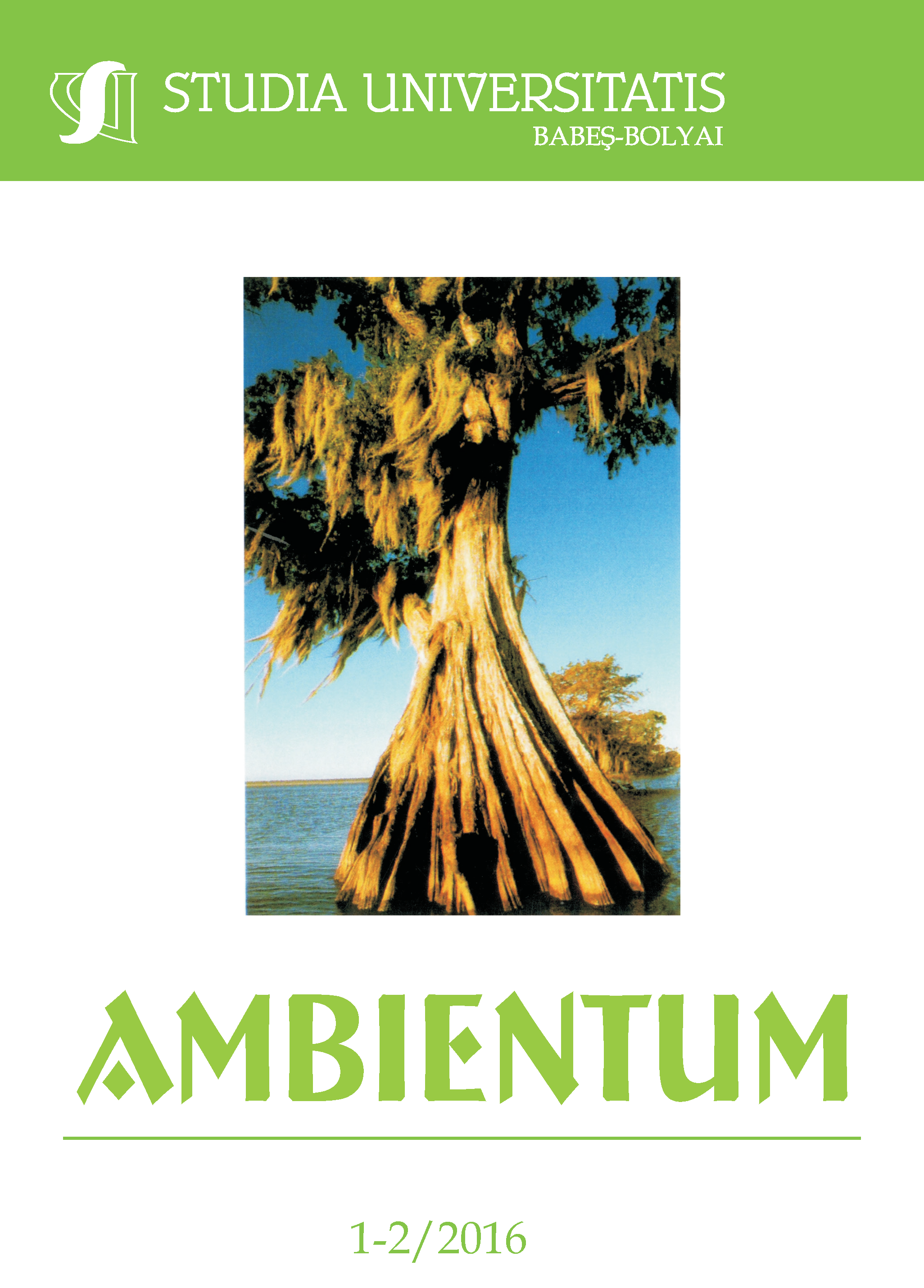STUDY ON TYPES OF SOIL DEGRADATION CAUSED BY FOREST EXPLOITATION
Keywords:
soil degradation, forest exploitation, sustainable environmentAbstract
Sustainable management and development of forest sector should become an essential element in the strategy of prevention of the degradation of the land of each state. The forests play an important role in debts settlement of water courses, in ensuring the water quality, in maintaining land stability including the erosion control, landslides or avalanches. Forest exploitation represents a main source on degradation on the soil, having a major impact on the environment. Accelerated erosion caused by forest exploitation and soil degradation has become the main factor which limits the sustainable use of the soil. Through irrational forest exploitation, the nature of damage that occurs is ecological, social and economic. Forests are sources of other goods and services for society, such as processed wood and non-wood products, space of recreation, landscaping, etc. The large number of sites affected as a result of the forest exploitation, emphasizes massive environmental risks and their existence without urgent action has a negative impact on human health and the environment.
References
Apetroaiei Ş., 1977, Evaluarea şi prognoza bilanţului apei în sol. Ed. Bucureşti, pp. 78 – 120.
Cerdà A., Hooke J. Romero-Diaz A., Montanarella L., & Lavee H., 2010, Soil erosion on Mediterranean Type-Ecosystems Land Degradation and Development. Editors. DOI 10.1002/ldr.968.
D'almeida C., Vörösmarty C.J., Hurtt G.C., Marengo J.A., Dingman S.L., and Keim B.D., 2007, The effects of deforestation on the hydrological cycle in Amazonia: A review on scale and resolution, Int. J. Climatol., 27, 633–647.
Davidson E.A, Janssens I.A, Luo Y., 2006, On the variability of respiration in terrestrial ecosystems: moving beyond Q10, Global Change Biology.
Dîrja M., Pepine A., 2008, Amelioraţii silvice. Îndrumător pentru întocmirea proiectului. Ed. Todesco, Cluj-Napoca.
Dîrja M., Budiu V., 2006, Îmbunătăţiri funciare. Combaterea excesului de umiditate pe terenurile agricole. Ed. Academic Pres, Cluj – Napoca, 209 p.
Eckelmann W., Baritz R., Bialousz S., Bielek P., Carré F., Houšková B., Jones R.J.A., Kibblewhite M.G., Kozak J., Le Bas C., Tóth G., Tóth T., Várallyay G., Yli H.M., & Zupan M., 2006, Common Criteria for Risk Area Identification according to Soil Threats. EUR 22185 EN. Luxembourg: Office for Official Publications of the European Communities.
Ferrier S. and Drielsma M., 2010, Synthesis of pattern and process in biodiversity conservation assessment: a flexible whole-landscape modelling framework. Diversity and Distributions, 16 (3), pp. 386-402.
García-Orenes F., Cerdà A., Mataix-Solera J., Guerrero C., Bodí M.B., Arcenegui V., Zornoza R. & Sempere J.G., 2009, Effects of agricultural management on surface soil properties and soil-water losses in eastern Spain. Soil and Tillage Research, 106, pp. 117-123.
García-Orenes F., Roldán A., Mataix-Solera J., Cerdà A., Campoy M., Arcenegui V., Caravaca F., 2012, Soil structural stability and erosion rates influenced by agricultural management practices in a semi-arid Mediterranean agro-ecosystem. Soil Use and Management, 28, pp. 571-579.
Gobin A., Jones R., Kirkby M., Campling P., Govers G., Kosmas C., & Gentile A.R., 2004, Indicators for pan-European assessment and monitoring of soil erosion by water. Environmental Science & Policy, 7 (1), pp. 25-38.
Harbek S.W., Reinhart K.G., 1964, Water Quality and Soil Erosion aş affected by Logging steep terrain. Soil and Water conservation, 19, pp. 23-27.
Haynes R.J., Naidu R., 1998, Influence of lime, fertilizer and manure applications on soil organic matter content and soil physical conditions: a review. Nutrient Cycling in Agroecosystems, 51, pp. 123-137.
Holmes S. E., Roy B. A., Reed J. P. & Johnson B. R., 2010, Context-dependent pattern and process: the distribution and competitive dynamics of an invasive grass, Brachypodium sylvaticum. Biological Invasions, 12 (7), pp. 2303-2318.
Kinnell P.I.A. and Risse L.M., 1998, USLE-M: empirical modeling rainfall erosion through runoff and sediment concentration. In: Soil Science Society of America Journal, 62 (6), pp. 1667–1672.
Kladivko E.J., Brown L.C. and Baker J.L., 2001, Pesticide transport to subsurface tile drains in humid regions of North America. Crit. Rev. Environ. Sci. Tech., 31, pp.1-62.
Kocyigit R., Demirci S., 2012, Long-term changes of aggregate-associated and labile soil organic carbon and nitrogen after conversion from forest to grassland and cropland in northern Turkey. Land Degradation & Development, 23, pp. 475- 482. DOI 10.1002/ldr.1092.
Kosmenko A.S., 1956, Combaterea eroziunii solurilor, ed. Agro-Silvica, Bucuresti.
Lathuilli M.J., Johnson M.S., Donner S.D., 2012, Water use by terrestrial ecosystems: temporal variability in rainforest and agricultural contributions to evapotranspiration in Mato Grosso, Brazil, Environmental Research Letters, 7 (2), pp 1-9.
Lee G.-S., Lee K.-H.,2006, Scaling effect for estimating soil loss in the RUSLE model using remotely sensed geospatial data in Korea Hydrology and Earth System Sciences Discussions, 3, pp. 135–157.
Liu J., & Taylor W., 2002, Integrating landscape ecology into natural resources management. Cambridge: Cambridge University Press.
Moţoc M., S. Munteanu, Băloi V., Stănescu P., Mihaiu G., 1975, Eroziunea solului şi metode de combatere, Editura Ceres, Bucureşti.
Moțoc, M., 1983, Ritmul mediu de degradare erozională a teritoriului României. Buletin Informativ ASAS, no. 12, Bucureşti.
Oroian I., 2010, Phytopathologie, ISBN 978 - 606 - 8191 - 09 – 6, Editura Bioflux Cluj – Napoca, 250 p.
Pongratz J., Reick C.H, Raddatz T., Caldeira K., Claussen M., 2011, Past land use decisions have increased mitigation potential of reforestation, Geophysical Research Letters, 38 (15), pp. 1-8.
Post W.M., Kwon K.C., 2003, Soil carbon sequestration and land-use change: processes and potential, Global Change Biology, 6 (3), pp. 317–328.
Scanlon B.R., Jolly I., Sophocleous M. and Zhang L., 2007, Global impacts of conversions from natural to agricultural ecosystems on water resources: Quantity versus quality, Water Resources Research, 43 (3), pp. 1-9.
Untaru E., 2010, Premise privind împădurirea terenurilor degradate în condițiile schimbărilor climatice generate de încălzirea globală. Revista Pădurii.
*** ICPA, 1986. Metodologia elaborării studiilor pedologice.
*** Revista padurilor nr. 3/2013.
*** Revista padurilor, nr 2/2010.
Downloads
Published
How to Cite
Issue
Section
License
Copyright (c) 2016 Studia Universitatis Babeș-Bolyai Ambientum

This work is licensed under a Creative Commons Attribution-NonCommercial-NoDerivatives 4.0 International License.





 ISSN (online): 2065-9490 | ISSN (print): 1843-3855 | ISSN-L: 2065-9490
ISSN (online): 2065-9490 | ISSN (print): 1843-3855 | ISSN-L: 2065-9490